This article needs additional citations for verification .(September 2010) |
Limeuil is a prehistoric site in the French departement Dordogne. It is renowned for nearly 200 engravings dating back to the Magdalenian.
This article needs additional citations for verification .(September 2010) |
Limeuil is a prehistoric site in the French departement Dordogne. It is renowned for nearly 200 engravings dating back to the Magdalenian.

The site of Limeuil is situated right in the center of the medieval village of Limeuil, near the confluence of the Vézère and the Dordogne rivers. At the close of the Upper Paleolithic the hunters had their encampment here below a small Santonian limestone ledge.
The finds were made on a 30 meter long slope below two limestone outcrops. The encampment was therefore mainly in the open, but was also enclosed later on by the partially overhanging rock ledge.
The archeological level was found accidentally during building work at the bakery of Léo Bélanger. The Ministry of Education then mandated J. Bouyssonie, a prehistorian from Brive, with a reconnaissance excavation. The work took place between 1909 and 1913 – a very difficult task because of the built up area.
All the finds from this single archeological level belong to the Magdalenian VI.
The stone artefacts are largely dominated by burins, some are of the bec de perroquet-type. Amongst the bone tools are harpoons with two rows of barbs. Characteristic for the end of the Magdalenian are engravings on bones or reindeer antlers. Amongst the art work stands out a pierced baton decorated with reindeers and fishes. On other pieces bisons and wild horses are depicted, one even carries the image of a fox – a very rare theme for the Magdalenians.
The engravings resemble the finds in Teyjat; they are very delicate and approach a nearly photographic realism. Like in Teyjat, depictions of deer and reindeer clearly dominate (about 50%), followed by horses (about 30%), aurochs, bisons and capricorns. Even two bears and the already mentioned fox are represented.
The originality of the Limeuil site is clearly due to the roughly two hundred engravings executed on limestone slabs of different sizes. Over a hundred were published by Bouyssonie. The sheer number of slabs led André Leroi-Gourhan to the assumption that Limeuil might have been a sanctuary, an art workshop or even an “academy”.
Important for the evolution of art is the first-time depiction of the ground between the extremities of some of the animals.
There are no absolute dates for Limeuil, but the style of the engravings is clearly Magdalenian VI, so the art work is attributable to about 12.000 years BP.

Lascaux is a network of caves near the village of Montignac, in the department of Dordogne in southwestern France. Over 600 parietal wall paintings cover the interior walls and ceilings of the cave. The paintings represent primarily large animals, typical local contemporary fauna that correspond with the fossil record of the Upper Paleolithic in the area. They are the combined effort of many generations and, with continued debate, the age of the paintings is now usually estimated at around 17,000 years. Because of the outstanding prehistoric art in the cave, Lascaux was inducted into the UNESCO World Heritage List in 1979, as an element of the Prehistoric Sites and Decorated Caves of the Vézère Valley.

Creswell Crags is an enclosed limestone gorge on the border between Derbyshire and Nottinghamshire, England, near the villages of Creswell and Whitwell. The cliffs in the ravine contain several caves that were occupied during the last ice age, between around 43,000 and 10,000 years ago. Its caves contain the northernmost cave art in Europe. The evidence of occupation found in the rich series of sediments that accumulated over many thousands of years is regarded as internationally unique in demonstrating how prehistoric people managed to live at the extreme northernmost limits of their territory during the Late Pleistocene period.

The Magdalenian cultures are later cultures of the Upper Paleolithic and Mesolithic in western Europe. They date from around 17,000 to 12,000 years ago. It is named after the type site of La Madeleine, a rock shelter located in the Vézère valley, commune of Tursac, in France's Dordogne department.

Font-de-Gaume is a cave near Les Eyzies-de-Tayac-Sireuil in the Dordogne départment of south-west France. The cave contains prehistoric polychrome cave paintings and engravings dating to the Magdalenian period. Discovered in 1901, more than 200 images have been identified in Font-de-Gaume. Along with other nearby prehistoric archeological sites, Font-de-Gaume was inscribed on the UNESCO World Heritage List in 1979 as the Prehistoric Sites and Decorated Caves of the Vézère Valley.

Limeuil is a commune in the Dordogne department in Nouvelle-Aquitaine in southwestern France.

Bison Licking Insect Bite is a prehistoric carving from the Upper Paleolithic, found at Abri de la Madeleine near Tursac in Dordogne, France, the type-site of the Magdalenian culture, which produced many fine small carvings in antler or bone.

The art of the Upper Paleolithic represents the oldest form of prehistoric art. Figurative art is present in Europe and Southeast Asia, beginning between about 40,000 to 35,000 years ago. Non-figurative cave paintings, consisting of hand stencils and simple geometric shapes, are somewhat older, at least 40,000 years old, and possibly as old as 64,000 years. This latter estimate is due to a controversial 2018 study based on uranium-thorium dating, which would imply Neanderthal authorship and qualify as art of the Middle Paleolithic.
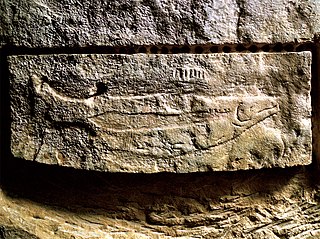
The Prehistoric Sites and Decorated Caves of the Vézère Valley is a UNESCO World Heritage Site in France since 1979. It specifically lists 15 prehistoric sites in the Vézère valley in the Dordogne department, mostly in and around Les Eyzies-de-Tayac-Sireuil, which has been called the "Capital of Prehistory". This valley is exceptionally rich in prehistoric sites, with more than 150 known sites including 25 decorated caves, and has played an essential role in the study of the Paleolithic era and its art. Three of the sites are the namesakes for prehistoric periods; the Micoquien, Mousterian, and Magdalenian. Furthermore, the Cro-Magnon rock shelter gave its name to the Cro-Magnon, the generic name for the European early modern humans. Many of the sites were discovered or first recognised as significant and scientifically explored by the archaeologists Henri Breuil and Denis Peyrony in the early twentieth century, while Lascaux, which has the most exceptional rock art of these, was discovered in 1940.

The Parc naturel régional Périgord Limousin was created March 9, 1998. It consists of 78 communes situated in the Dordogne and Haute Vienne départements. The park has a surface area of 1,800 square kilometers and is inhabited by 49,661 people.
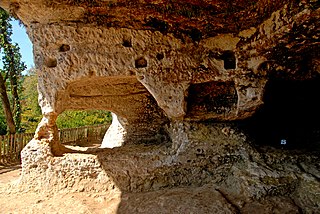
The archaeological site Abri de la Madeleine is a rock shelter under an overhanging cliff situated near Tursac, in the Dordogne département of the Aquitaine Région of South-Western France. It represents the type site of the Magdalenian culture of the Upper Paleolithic. The Bison Licking Insect Bite, a 20,000 year old carving of exceptional artistic quality, was excavated at the site. The shelter was also occupied during the Middle Ages. The medieval castle of Petit Marsac stands on the top of the cliff just above the shelter. An engraved bone rod from the cave, depicting a lioness licking the opening of either a gigantic human penis or a vulva, shows the first documented act of bestiality.

The Rouffignac cave, in the French commune of Rouffignac-Saint-Cernin-de-Reilhac in the Dordogne département, contains over 250 engravings and cave paintings dating back to the Upper Paleolithic. In conjunction with other caves and abris of the Vézère valley, the Rouffignac cave was classified a Monument historique in 1957 and a world heritage site in 1979 by UNESCO as part of the Prehistoric Sites and Decorated Caves of the Vézère Valley.

Raymonden is a prehistoric cave near Chancelade in the French département Dordogne. The cave was inhabited during the Upper Paleolithic and contained, besides many artefacts, a human skeleton.
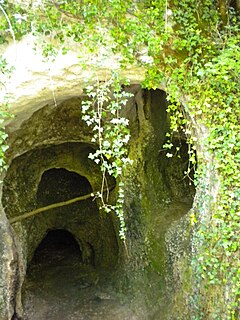
Rochereil is a prehistoric cave near Lisle in the French département Dordogne. Besides around 4000 stone and bone artifacts it contained the tomb of an adult human, the perforated skull of a two-year-old child and fossilized bones of two adolescent individuals.

The Cantabrian caves' unique location make them an ideal place to observe the settlements of early humans thousands of years ago. The magnificent art in the caves includes figures of various animals of the time such as bison, horses, goats, deer, cattle, hands and other paintings. Archaeologists have found remains of animals such as bears, the remains of arrows and other material indicating a human presence; these artifacts are now found mostly in the Regional Museum of Prehistory and Archaeology of Cantabria.

The Villars Cave, in French Grotte de Villars or Grotte du Cluzeau, was occupied during the Lower Magdalenian by Cro-Magnon hunter-gatherers. The cave is part of the French commune of Villars in the northern Dordogne département. Besides its enormous wealth in beautiful stalactites, stalagmites and similar calcite deposits it contains cave paintings and some engravings. The Villars Cave and the Rouffignac Cave are the biggest known cave systems in the Dordogne.
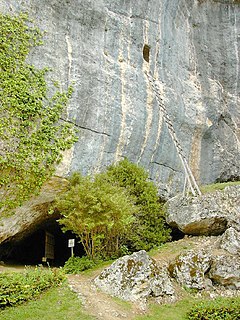
Laugerie-Basse is an important Upper Paleolithic archaeological site within the territory of the French commune Les Eyzies-de-Tayac-Sireuil in Dordogne. It is known for several works of art from the Magdalenian. In 1979, Laugerie-Basse, along with other nearby paleolithic sites, was inscribed on the UNESCO World Heritage List as Prehistoric Sites and Decorated Caves of the Vézère Valley.
Las Caldas Cave and the surrounding partial nature reserve is a protected area covering 45 hectares within the Nalón Valley in the Municipality of Oviedo in the vicinity of the towns of La Piñera and Las Caldas.

The El Mirón Cave is a large cave in the upper Asón River valley towards the eastern end of Cantabria in northern Spain, near the border of the Basque Country. It is an archeological site in Ramales de la Victoria. It is known for a skeleton belonging to a woman nicknamed The Red Lady of El Mirón. She is estimated to have died around 18,700 years ago, during the Upper Paleolithic (Magdalenian). The skeleton is examined to that of someone between 35 and 40 years. Her bones were coated with ochre, a red iron-based pigment, hence, her name.
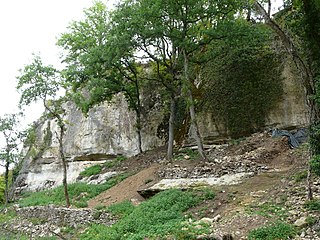
Castel Merle is a complex of 10 prehistoric rock shelters in Sergeac, in the Dordogne region of France. It is close to the Lascaux rock art caves and is situated in the region which forms the Unesco World Heritage site Prehistoric Sites and Decorated Caves of the Vézère Valley, but is not officially a part of it. The finds in the shelters date to the Mousterian and Magdalenian periods, or between 160,000 and 12,000 years ago. The most important of the 10 shelters is the Reverdit rockshelter.